The rule of beauty is subtle, even insidious. Rome speaks directly to the body. English poet Elizabeth Jennings exclaims, "O and the heart is drawn to sense, Eye and the mind are one." Eros is part of the city's allure, certainly, but so is an ambient violence, whether felt in the brooding hulk of the Colosseum or in a sudden traffic accidents. Rome offers you a kaleidoscope of brilliances, but does not care what you do with them, because so many have come before you.
Don't wanna be here? Send us removal request.
Photo

Monument to Pope Pius VIII, Pietro Tenerani (1866), Saint Peter’s Basilica, Rome, Italy.
1K notes
·
View notes
Text
Castel Sant’Angelo (Hadrian’s tomb) and Tomb of Augustus
As embarrassing as it is to say this, my introduction to Castel Sant’Angelo came not from visiting the site, but from this little movie called Angels and Demons. The conspiracy filled movie did manage to convince me of how remarkable this site since it is usually overlooked by what’s down the street. The bridge of Angels leading up to the Castel Sant’Angelo is nothing by awe inspiring, not only because it is positioned above the river, but also because you’re out in the open and you’re looking at this tomb, which his bizarre in a way, but the angels and all their different poses make you feel heavily guarded and safe. The fact that it functioned differently throughout history (mausoleum for Hadrian, fortress, Papal house, and museum) is also pretty impressive. At the top is a large statue of none other than Archangel Michael himself who apparently appeared and landed on the castle, ending the 590 AD plague the moment he put his sword back into its scabbard.


Another mausoleum, not too far from Hadrian’s, is the tomb of Augustus, which is one of the emperor’s first major building projects in Rome. It’s said to have been inspired by the mausoleum of Alexander the Great in Alexandria, Egypt. Due to the poor preservation of the building, it doesn’t look as grandeur as any of the sites we’ve discussed thus far. It is weird to say but the greenery surrounding the building from everywhere does make it look aesthetically pleasing in a way. The trees and vines bring the concrete and large limestone blocks to life. It was supposed to open for visitors spring of this year but sadly, that didn’t happen. Hopefully soon though…

3 notes
·
View notes
Text
Catacombs of San Sebastiano & the Memoria Apostolorum
Just like Sant’Agnese, a basilica was built above the catacombs of San Sebastiano. The area was used for pagan tombs at one point in time but was later used by Christians to build chapels and tombs for their deceased. The remains of San Sebastian were buried at this site, hence the building of the basilica above the hollows. However, the name of the church derives from the fact that it was built over an earlier structure which was called Memoria Apostolorum. This memoria was removed so the new basilica of Constantine would be built over it and we only know about this first structure through the excavations on site. The walls of this older building contained graffiti that recorded the names of Saint Peter and Saint Paul, and it has been argued that the relics of Saint Peter and Saint Paul may have been kept on this site for a while and was in turn commemorated and used in prayers in the Memora Apostolorum. As for the catacombs, the passageways are a mixture of monumental tombs and mausoleums as well as smaller galleries decorated with mural paintings. The central chapel is believed to have been used by both Christian and pagans during funerary prayers. This chapel is decorated with acanthus and lotus leaf stucco paintings, while other chapels contain, what could be argued as, Christian symbols such as fish and anchors.





#Catacombs of San Sebastiano#Memoria Apostolorum#Catacombs#Roman Catacombs#Rome#Basilicas#Basilica#Saint Peter and Saint Paul#St. Peter#St. Paul
1 note
·
View note
Text
Complex of Sant’Agnese fuori le mura
The basilica of Sant’Agnese, built above the catacombs that house the remains of the martyr St. Agnes, shows many Eastern stylistic influences since it was built under the Byzantine rule. The façade isn’t as striking as other basilicas across Rome but the organization and placement of the brick does make it look decorated. The basilica has a nave and aisles separated by ancient Roman columns. There is also a narthex and galleries that face the three side of the central nave, and arches above the colonnades that are heavily decorated with images of saints and Christian symbols. Portrayed on the mosaic of the apse is St. Agnes wearing imperial clothes and holding a scroll sealed with a cross. She is flanked by two figures, one of which holds a model of the church. The gold of the background sets the figures apart as well as the vision of heaven above with the hand of God reaching down to St. Agnes. As for the catacombs, they could be reached through a room at the end of the left aisle and unlike the other catacombs, the walls are not decorated with frescoes or paintings. The galleries of these underground passageways are much smaller and shorter than those of the others, and it is believed that the complex was actually a private catacomb that only became public much later. Most of the epigraphs in these catacombs are plundered and only a few can help in dating these caves. The complex, including the catacombs, is impressive in its own way but not as much as the others…




#Complex of Sant’Agnese fuori le mura#Sant’Agnese fuori le mura#Sant’Agnese#Catacombs#Roman Catacombs#Rome#Basilica#Basilicas
1 note
·
View note
Text
Catacombs of Domitilla
Named after Saint Domitilla, these catacombs spread over ten miles and are considered to be one of, if not the, oldest of the underground hollows in Rome. This underground necropolis contains thousands of graves and its walls have been preserved and heavily restored, giving us a fantastic view of the rich pagan and Christian cultures held in its multiple levels. A clear scene depicting the Last Supper is seen in one of the passageways. Because many of the early Christian symbols and iconography used was appropriated from pagan works of art, we find that much of the imagery in these catacombs could belong to pagans or Christians. The grapes and cupids could have been used by both groups and you can only argue if a tomb belonged to a Christian if you see these decorative elements mixed with saints and crucifixes like the painting that depicts the martyrs Veneranda and Petronilla. Even the frescos of the Good Shepherd, which are in the Chamber of the Millers, fall under both religions since the figure could be a representation of Christ or of Hermes and Orpheus. It’s even more confusing when you notice the surrounding depictions of the seasons. It ultimately doesn’t really matter because when you first see these preserved wall and apse paintings, you are overwhelmed by the history kept within these hollows. And with the Catacombs of Domitilla, you get a better sense of this history when you realize that this site is known for the martyrs Nereus and Achilleus who are buried in the basilica. All in all, it’s a sacred space.







#Catacombs of Domitilla#Domitilla#Catacombs#Roman Catacombs#Rome#Pagan Catacombs#Christian Catacombs#Wall frescoes
1 note
·
View note
Text
Catacombs of Priscilla
Located in one of the quarries used during Roman times as a burial site, the Catacombs of Priscilla also contain wall frescoes of saints and Christian symbols. One of the more important features of these catacombs is a Greek Chapel (square chamber with an arch) that holds many frescoes believed to be depicting scenes from the Old and New Testament. There is also an illustration of the Last Judgement on the apse of this chamber as well as the Adoration of the Magi. Other chambers also include Christian-related themes such as the Annunciation, the Good Shepherd (refer to this link for more on the history of this theme), and the Three Babylonian Youths thrown in the Furnace. However, not all the illustrations are overtly Christian. We also see frescoes of “neutral” themes such as those depicting coopers, meal scenes (this one could be Christian because of the five loaves and two fish), and scenes from a woman’s life that illustrate marriage, childbirth and death. Some of these scenes do lean towards being more Christian than neutral so it just depends on which interpretation you’d want to stick with. Besides the frescoes that tell us the preferences of those buried there, we also get epigraphs with many of the tombs that sometimes tell us the names of the deceased and those who buried them here. If we’re really lucky, we get dates and other terms that hint to their social status.
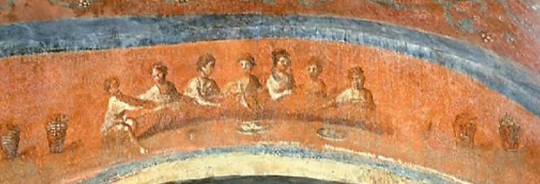



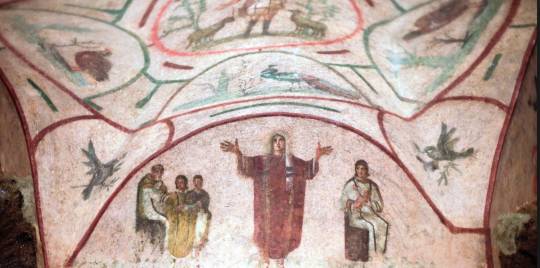
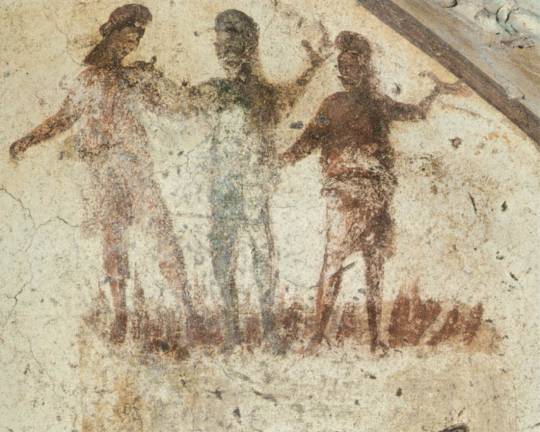
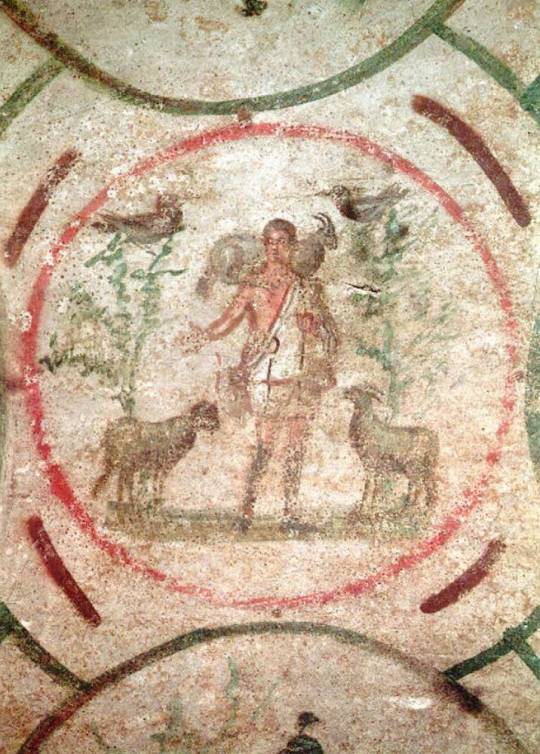
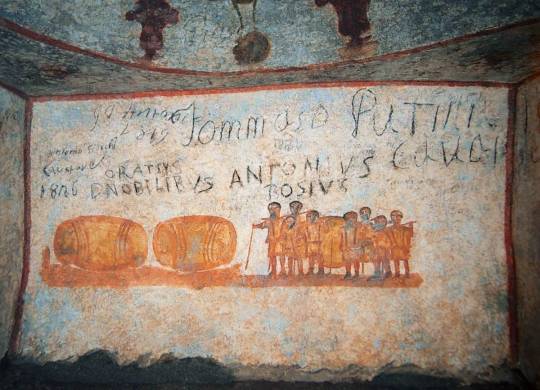


#Catacombs of Priscilla#Catacombs#Priscilla#Roman Catacombs#Rome#Pagan Catacombs#Christian Catacombs#Epigraphs
2 notes
·
View notes
Text
Catacombs of Via Latina
Besides the lavish basilicas, Rome is also known for its remarkable catacombs, not only because of how impressive the architecture is but also because we can get a sense of what early Christian art may have looked like, since the earliest dated art that could be identified as Christian comes from the frescoes and paintings on the catacomb walls running beneath the streets of Rome. The excavations of these underground cities show the careful and brilliant design and arrangement of the spaces. And the Catacomb of Via Latina is among those that illustrates the complexity of its patrons. Just looking at the rich decorations and considerably complex artistic elements tells us that the patrons of these tombs were most likely financially comfortable. The artistic standard required to include some of these pagan and Christians themes hints to a rich audience. The frescoes, consisting of narrative and cyclical forms of biblical themes and everyday life, fit well with the funerary context. The paintings in these burial chambers depict a variety of themes, with some recording the Personification of the Earth while others depict Hercules and the Hydra. We also see more Christian themes such as Daniel in the Lions’ Den, the Raising of Lazarus, and Christ meeting the Samaritan woman. Then there are the themes that aren't really considered as Christian or Pagan like the Death of Cleopatra and the construction of a villa. But even though these themes may appear drastically different from each other, the meanings behind the scenes all share one thing: they all connect to the deceased in some way or another.








#Catacombs of Via Latina#Via Latina#Rome#Catacombs#Roman Catacombs#Pagan Catacombs#Christian Catacombs#Wall paintings#Frescos
6 notes
·
View notes
Text
Palazzo Altemps
Although the collection holds around 100 sculptures, the main feature of the Palazzo Altemps would have to be the courtyard that showcases four colossal sculptures along with a sarcophagus and two heralds of gods that are part of the decorations of the fountains. The four sculptures, Maenad, Hercules Sitting, Gladiator at rest, and a Female figure, rule over the outer space of the museum. What’s interesting about these sculptures is the fact that both of the female figures are standing upright with their arms reaching upward while the two male figures are sitting down or hunched over, neither of which seem to be paying attention to the viewer bur rather something else. Still, their authoritative nature almost feels as if it’s forcing you to admire their figures.

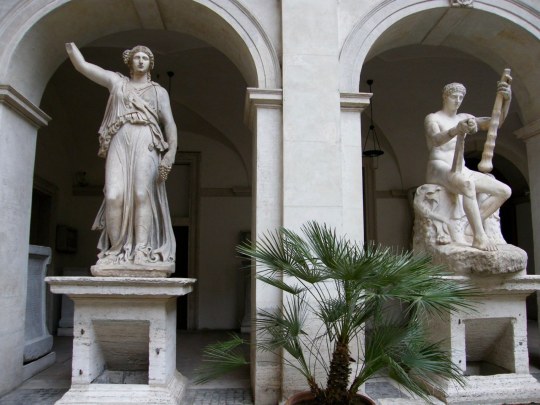
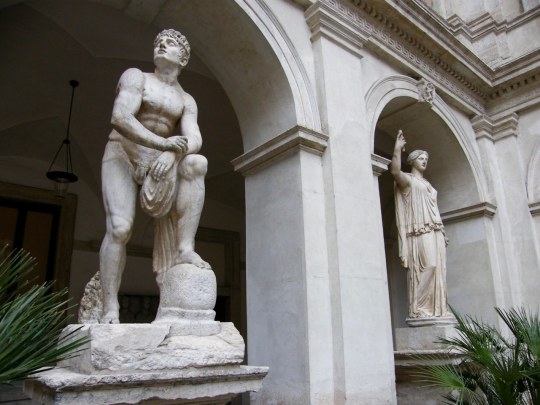
As mentioned, the main collection of the museum consists of over 100 statues but there are three other smaller collections under the roof of the museum. There is the Mattei Collection which is mainly ancient Roman sculptures, the Drago Collection which are four reliefs form the del Draga family, and the Egyptian Collection, which contains ancient Egyptian statues and Roman statues that were created in an Egyptian style. Once more, I will divert your attention to two specific sculptures that caught my eye, the Ludovisi Ares and the Galatian’s Suicide with his Wife. Unlike what we know about him, Ares looks incredibly calm and collected seated on that rock/throne. His hands rest on his knee as they grip his sword which makes the viewer think he is about to spur into action at any moment should war comes to him. A small figure of Eros lays at the feet of Ares, looking up at him in admiration or fear, perhaps even both. It’s tragically poetic, the fact that love lays, in a way, at the mercy of the wager of all wars. Perhaps they are more attuned to each other than we think because like love, war is very easy to begin but hard to stop.
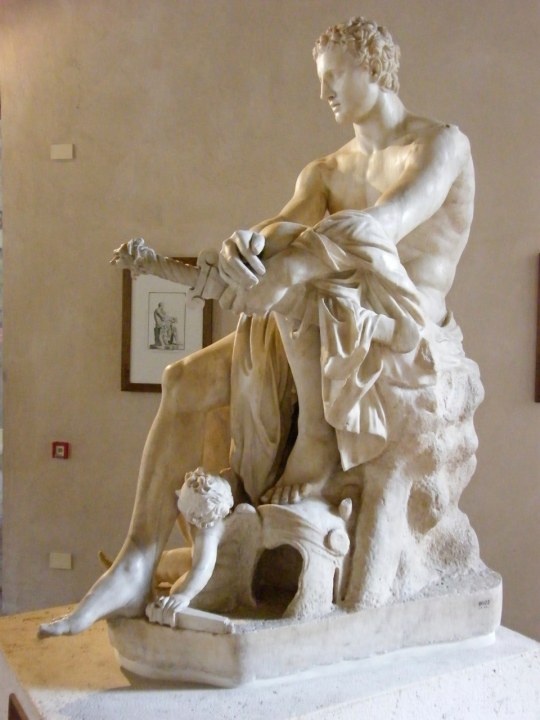

Moving on to the second statue, we find a statue of a Galatian warrior who is in the process of committing suicide right after killing his wife. As many of the other sculptures, the statue is full of violent movement that perfectly exudes pain and loss. The dying wife looks heavy as she falls down to the ground while the Galatian warrior turns his head to the opposite direction as he stabs himself. It is a curious decision to depict the man turning the other way because you aren’t sure if he wished to not look upon his wife or if he refuses to acknowledge the metal digging through his flesh. Moreover, you aren't sure where you should be looking first because the twisting of the torsos and legs of both of figures makes it hard to focus on one spot. The dramatic elegance of the couple makes their expressions difficult to ignore.

#Palazzo Altemps#Ludovisi Ares#Galatian’s Suicide with his Wife#Rome#Museums#Museum#Marble Sculptures#National Roman Museum
97 notes
·
View notes
Text
Palazzo Massimo alle Terme
The Palazzo Massimo alle Terme is the largest of the Museo Nazionale Romano. There are numerous collections on this site; the jewels, coins and other types of ornaments are kept in the basement houses while the ground and first floor contain sarcophagi, reliefs, and original Greek sculptures as well as Roman copies of Greek originals. Colorful Roman frescoes are placed on the second floor along with a vast collection of mosaics. Worth mentioning are the frescoes from the Villa of Livia that depict a naturalistic garden filled with birds and vegetation. This is where my bias will jump out again because I am incapable of not ranting about sculptures and no I will not be fangirling over The Boxer even though his face is practically looking up and begging me to “admire” him. And just to be fair, I will focus on one female sculpture and one male sculpture, both of which call the viewer to admire their beauty.
We’ll start with the statue of Aphrodite carved by Menophantos. To anyone who gazes upon her, Aphrodite looks as if she is attempting to cover her breasts with her hands and her navel with the drapery she is pulling from the floor. But for anyone who knows Aphrodite, that’s probably as far away from reality as it could possibly get. Her facial expressions reveal her teasing nature, almost as if she is daring the viewer to look at her. She isn’t actively trying to keep her decency, on the contrary, she is purposely moving slowly to show the viewer as much of her smooth, curvy skin as possible. And you can even walk around her to admire every nude inch of her erotic beauty.

The second sculpture, the Discobolus Lancellotti by Myron, can also be admired from any perspective. Because it is marble, you’d expect it to look still, but the figure is anything but that. The fluidity of his movements mixed with the tense muscles of his chest and the popping veins of his arms and hands bring the sculpture to life. You can almost expect the disk to be thrown any moment. Even his calves look strained. Surprisingly, the most erotic feature of the sculpture is the thrower’s face because if his body exudes “energy,” his face yells “calmness.” There is just something beautiful about a strong body, relying on the plasticity of its joints to throw a heavy discus, showing little to no emotion because it isn’t taking too much energy to bring the action to an end.



#Palazzo Massimo alle Terme#Palazzo Massimo#Discobolus Lancellotti#Aphrodite#Menophantos#Myron#Marble Sculptures#Rome#Roman Museums#Museums#National Roman Museum
2 notes
·
View notes
Text
Museo Nazionale Romano
Similar to the Musei Vaticani, the Museo Nazionale Romano spread out across a few different buildings or “smaller” museums: the Baths of Diocletian, the Palazzo Altempts, the Crypta Balbi, and the Palazzo Massimo (aka the Palazzo Massimo alle Terme). The National Museum of Rome is considered to house the world’s largest collection of Classical Greco-Roman artworks of different mediums. The Diocletian Baths were renovated/reconverted into an exhibition space in the early 20th century and it was not until later that the collections of the main museum were moved to the Palazzo Massimo alle Terme, which gets its name from being in close vicinity with the Baths of Diocletian. Speaking of which, the Baths of Diocletian are known to be the largest public baths in Rome and ironically, their ruins somehow managed to maintain their beauty until today. Another section of the museums is the Crypta Balbi which was created after some archaeological excavations were made in the area. Walking through the location, you can still recognize the original locations of some of the buildings. The exhibit houses thousands of objects, some of which (e.g. glass, lead, ceramics) are well-preserved while others weren’t so lucky. And if you like ancient coins, then this is the place for you. Overall, the Crypta Balbi functions as an illustration of the progression and evolution of Roman society, commercial activity and urban cityscape from ancient times until modern times.


#Museo Nazionale Romano#National Roman Museum#Baths of Diocletian#Palazzo Altempts#Crypta Balbi#Palazzo Massimo#Palazzo Massimo alle Terme#Rome#Museums#Roman Museums
2 notes
·
View notes
Text
Santa Maria in Trastevere
Dominating the main piazza of the Old Trastavere quarter, the church of Santa Maria looks incredible in the early mornings because of the medieval mosaics that decorate the top of the exterior façade. The lower mosaic program illustrates the Virgin Mary sitting on a throne with saints surrounding her and giving her offerings. Above that mosaic is a pediment filled with fresco drawings of (presumably) a similar theme. Another impressive decorative element is the row of statues standing on the terrace right below the mosaics. The statue of the Madonna and Baby standing on top of the tower of the church. Although the façade doesn’t appear to be as lavish as some of the basilicas we have discussed so far, the combination of the frescoes, mosaics, and sculptures do give the church its unique character. Once you walk inside, you see the same wooden, gilded ceiling of the other basilicas as well as the fantastic mosaic program decorating the apse. Painted in the middle of this ceiling is a scene of the Assumption of the Blessed Virgin. The transept is separated from the nave and actually has its own coffered ceiling colored in gold, blue and red. Some of the columns that line the nave might look ancient and that’s because they actually come from the ancient Roman Baths of Caracalla. Moving to the end of the nave, we are met with the regular mosaic program in the apse, the main scene of which shows Christ enthroned next to Saint Mary, along with saints and popes. The Hand of God the Father comes from above the head of Christ. The space above them consists of many geometric shapes on top of a colorful background, unlike the gold that dominates the rest of the apse. There are other characters displayed on the apse as well, most likely from the Old and New Testaments, perhaps such the Old Testament. There are also symbols of the four Evangelists as well as the symbol of the Alpha and Omega which represent God the Father. Finally, right below the main apse mosaic is a frieze of the Lamb of God (Christ) standing in the middle of his twelve apostles, also represented by sheep. The basilica apparently contains crypts for a couple of popes…


1 note
·
View note
Text
San Crisogono
Although not as popular or impressive as Santa Cecilia and Santa Maria, the church of San Crisogono is still exceptional, particularly because of the remains of the Constantinian Christian church and Roman houses right beneath its grounds. Before you enter, you can clearly see the bell tower and he Romanesque façade of the basilica but once you go inside, it’s all Baroque style, including the Baldachino and side chapels. Like the other churches, the wooden ceiling is carved and gilded with gold, while the floor of the nave and aisles is made of cosmati. But the plan is actually different from regular basilicas because it only has a single nave. The apse is unlike other basilicas as well because it does not cover the curve of the space but is rather inside a small rectangular panel frame. The mosaic depicts the Madonna and Child at the center with Saints Chrysogonus and James flanking the two figures sitting on the throne. Moving to the old church on the premises, there are a few deteriorated frescoes that represent San Crisogono, Saint Benedictus, and other saints decorating the right and left walls. Going back to the excavations done on site, a number of basins were found, the large one of which faces the apse of the church. This baptistry also houses frescoes of Saint Benedict on its walls. What’s really terrifying is the one open sarcophagus down in the crypts that still has bones…





6 notes
·
View notes
Text
Santa Cecilia in Trastevere and Excavations Underneath
For those of you who obsess over everything Basilica-related, the first thing you’ll notice with this church is that it does not have a transept or a north tower. But the medieval bell tower makes up for this. The exterior is made entirely of brick and the entrance contains a portico that includes an architrave and numerous inscriptions and fragments of different architectural elements. There are a few side chapels and aisles around the nave once you enter, and the choir towards the end is raised, giving a view of the crypt that holds St. Cecilia's tomb beneath. In front of the choir is a sculpture of St. Cecilia’s allegedly incorrupt body. Although we can’t see her face, the sculpture is incredibly emotional and heartbreaking. Her body is twisted and the drapery shows the contours of her rested body but the pose itself, especially the way the arms are draping over the body, illustrate the pain of the saint before she was martyred. The apse right above the choir depicts a mosaic of the Second Coming, with Christ in the middle as saints flank Him on both sides. The background is a beautiful meadow landscape with flowers, trees and even some clouds. Below this scene stand the Lamb of God surrounded by other sheep that do not have halos around their heads like the sheep in the middle. Below this row is a long inscription made of gold.

But if the interior of the church is exceptional, the excavations beneath the church are much more impressive. You descend to the crypt through the left aisle where the sacristy is. Once you go underneath the church, you are met with a large and complex structure. There is an ancient baptismal font in the spacious area as well as the remains of some thermal baths and Roman houses, one of which belonged to St. Cecilia and her family. Walking along the tunnel leading away from the baptismal area, you come into view with the rest of the crypt decorated with cosmati. The arcaded vaults with rosettes and seraphs almost make the crypt look heavenly even though it is below the ground. There are frescoes and mosaics decorating the walls, the ceilings and the columns of the area, all of which are remarkably preserved! Also found in this crypt are the tombs of several martyrs include St. Cecilia. The mosaics filling the space of the crypt are indescribable. One final interesting detail is the pagan shrine in one of the nearby rooms that consists of a niche with a relief of a goddess in front of an altar, and a Dionysian scene on the sides of the niche which heavily implies that one of the Roman houses discovered in this crypt much have belonged a pagan family.






#Santa Cecilia in Trastevere#Santa Cecilia#Trastevere#Excavations#Basilica#Basilicas#Basilica Excavations#Rome
4 notes
·
View notes
Text
Santa Croce in Gerusalemme
Somehow, the Basilica of the Holy Cross in Jerusalem is usually overlooked by tourists even though it’s not too far from the Basilica of St. John Lateran. The church was founded by none other than St. Helena, the mother of Constantine and it was actually originally built within a part of the imperial palace where Queen Helena lived. Tradition says that the church was built after Helena returned from Jerusalem following her finding of the Cross of Christ among other relics of the Passion. She then brought them to Rome and built this magnificent building to house the objects. Not surprisingly, the apse of the church contains a massive fresco which refers to this exact event, The Finding of the Cross. The blue of the background grabs your attention immediately because you can’t decide whether you should focus on the vibrant color of that sky or the figure at the center of the heavens or the crowd at the bottom that just discovered the cross. It’s almost as if it’s a regular landscape scene that you could see if you step out of the church and the seated figure of Christ at the center of the sky makes it all the more surreal. One other thing that does grab your attention is the work done on the floor of the basilica because it is surprisingly colorful and symmetrical in its geometric patterns.
On the walls of the stairway that lead to the Chapel of the Relics are depicted the Stations of the Cross. Between these are stone tablets that refer to the Passion of Christ, with the final text on the left reading, “ECCE LIGNUS CRUCIS IN QUO SALUS MUNDI PEPENDIT VENITE ADOREMUS.” The chapel allegedly contains many ancient relics, the most important of them being some pieces of the wood from the Cross of Christ. All of the relics are kept in lavish gold reliquaries so you’re pretty much just seeing that and not the actual relics. Still, knowing that you’re standing so close to objects that may or may not be associated with the most well-known historical figure of all times is out of this world (no pun intended).



1 note
·
View note
Text
St. John Lateran
Extra. That’s the only word that comes to mind when you stand in front of and inside the Archbasilica of St. John Lateran. The façade is made of so many sculptural elements that you can’t decide whether the building is a giant sculpture or if its architecture made of little architectural features. It’s proportional, whether we’re talking of the columns “holding” up the basilica, the arches on the second floor, or the sculptures on the roof. It’s aesthetically pleasing even though it’s just white marble. Carved into the triangular pediment are two angels that face each other. They are holding a sphere with an image of Christ the Pantocrator in the middle which is probably hard to see if the sun isn’t hitting it at the right angle. Above the pediment, at the center, is a sculpture of Christ holding onto the cross with one hand while his other reaches out towards those approaching the basilica. The Chi Rho monogram is carved right below the feet of His sculpture. What’s really fascinating about the sculptures at the top is how much they balance each other, not just in number but also in stance. They’re not necessarily mirroring each other’s movement but the movement itself flows with the opposite side. Hence the extra-ness of it all.

Then you step through the massive bronze doors of the basilica which previously used in the Roman Forum, and you realize that the outside is nothing compared to what’s inside. As much as I’d like to rant about the apse again, I won’t say anything except this: the blue of the sky where Christ is staged in contrasts beautifully with the gold of the earth where the figures of saints are standing and surrounding the Cross. Also, the space below the apse, where the altar is, contains geometric patterns made out of marble and it adds an extra something to the entire corner of that church. The canopy includes a vibrant Crucifixtion scene surrounded by sculptures with some blue and gold covering the marble columns and the small arches below. The ceiling is pretty much all gold with some blue and red filling the spaces between the designs of the ceiling. The interior, with its impressively large arches, is obviously proportional but one thing that does stand out is how parts of it, such as the ceiling, the apse, and the canopy, and the floor, are full of colors while the main nave is white stuccos and dark marbles. These are drastic differences but they do complement each other.



The last thing I want to focus on is, not surprisingly, the sculptures! Staged around the space are twelve colossal statues of the twelve apostles and you can recognize each one of them through the hagiographic icons (i.e. objects they’re associated with) they’re holding in their hands. I’ve said it before and I’ll say it again, the marble looks like it’s about to move at any moment. The drapery, the contrapposto, the stillness, the slow authoritative movement. It’s perfect. Whether you’re looking at St. Bartholomew with his skin in his hands or St. Peter with the keys of the church, each of the apostles looks like he was caught mid-sermon. They’re incredibly muscular and energetic and the marble looks like its about to break and release them. Beautiful.

St. Matthew

St. Batholomew

St. Paul

St. Peter
1 note
·
View note
Text
Church of San Clemente
As much as I want to jump right into the apse of this church, I’ll start with the exterior because if we’ve proven anything so far, it’s that the exterior doesn’t always reflect the interior. So, this church is just a few yards from the Colosseum and it occupies almost an entire city block in downtown Rome. The exterior is plain, white, and brown. There is nothing wrong plain, slightly deteriorating exteriors because like many of the other churches, the façade is sculptural in its way, especially with the raised parts of the walls the almost look like Doric (perhaps Ionic) columns. But then you go inside and your mind is blown from the very different art styles that take up different corners of the church. You have some medieval frescoes over the altar which we will discuss in a second, an incredible baroque ceiling (it’s my favorite style so I’m obviously biased), cosamati marble floor, and of course, a couple of different architecture and art styles that make up the remains of the church on the right hand side of the main church. The main church and the old church are separated by these lovely arches with Corinthian (maybe Ionic) columns so you’re getting a sense of the classical style as well. It’s weird but it works (I'm pretty sure I said that a couple of times already). This old church has an incredible illustration of Christ descending in Hades to collect the good souls from the Old and New Testaments so they could go with Him to paradise. It’s also bizarre because there is a demon holding onto the leg of Adam that makes you think of how long this poor guy had to wait for Christ to get him out of there. One last thing I want to point out before we look at the apse is the ceiling of the main church. It’s wooden with blue and gold coffering. The fresco is pretty impressive but as much as I hate to say it, it isn’t as impressive as the apse.


The apse… The apse of San Clemente is out of this world because so much gold. Gold everywhere! Standing at the center of the apse is a Crucifix, with two figures flanking the crucified body of Christ, presumably St. John the Beloved and the Virgin Mary. Doves are standing at the head, hands, and feet of Christ and we see the Cross rising from plants. The Hand of God is seen reaching from the top of the Cross and small clouds surrounding it are meant to represent the heavens. There are many decorative and floral elements everywhere, most of which take up the space of the entire apse. All of this vegetation is contrasted to the bright gold of the background and imagining what this church must took like during service hours gives me the chills because there’s probably lots of light bouncing off of the tiles of the mosaic. Some more figures are standing and sitting below the spiraling vegetation and we even see animals eating from those plants at the bottom of the apse. Below this illustration stands a line of sheep, the central one appearing much brighter and whiter then the others with a halo around its head. We can only assume that this is Christ as the Lamb of God surrounded by twelve other sheep that could represent the disciples or the tribes of the Old Testament. The Lamb of God is placed perfectly since the altar is right below and there is nothing more beautiful to illustrate the Eucharist than this illuminated lamb standing below the Crucifix.


1 note
·
View note
Text
Church of the Santi Quattro Coronati
The church of Santi Quattro Coronati takes its name after four martyrs who were put to death by Emperor Domitian. At first glance, the basilica looks less like a religious site and more like a fortress. The building consists of two courtyards, a Cardinal Palace with a chapel named after St. Silvester, and a monastery with a cloister façade. You have to walk through the two courtyards to get to the church. The Chapel of St. Silvester is entered from the right side of the second courtyard and once you go in, you’re met with a white ceiling vault that includes a pattern of crosses in red and stars in grey across. The chapel houses a fresco of the Last Judgement and perhaps more interesting, some inaccurate historical events on the right and lefts walls. Moving to the main sanctuary, you walk down a small nave and I say it’s small because it is disproportionate compared to the large apse at the end. The apse is of course filled with frescoes and stucco work in gold and white. The theme is Heaven, and we see the Trinity at the top surrounded by St. Mary and St. John the Baptist. There are angels flying around as well as saints praising them below. One very weird but fascinating thing about the angels is that many, if not most of them, are female! There are two registers of frescoes below the apse that include panels which illustrate the suffering, death and burial of the soldiers and stonemasons whom this church is dedicated to. Because of the severe damage this basilica sustained, there are a lot of elements that don’t look right due to the difference in scale. But if you were to go on a quiet trip to avoid the crowds around the other nearby churches, then this basilica will be perfect because it’s just a little splice of heaven, especially with the courtyards and cloisters.


#Church of the Santi Quattro Coronati#Santi Quattro Coronati#Basilica#Basilicas#Stucco work#apse#courtyards
1 note
·
View note